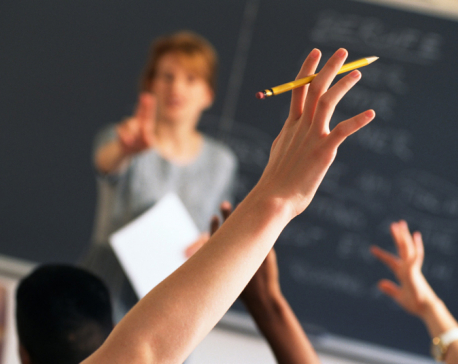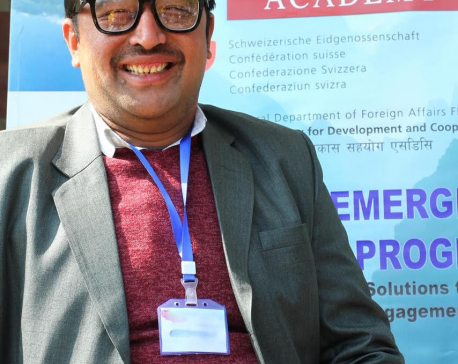
OR


Simone Galimberti
Simone Galimberti is the Co-Founder of ENGAGE, an NGO partnering with youths to promote social inclusion in Nepal.simone_engage@yahoo.com
Each student, motivated or demotivated, engaged or disengaged, has strengths that can be enhanced through practice and process of self-confidence building
Over the past few months, I had the opportunity to lead a skills lab for bachelor’s degree students of social work, trying to help them bridge the gap between theoretical and practical knowledge. There is no training that can make a youth completely ready for a job as only a continuous and engaging “on the job” experience can help her become the best she can be.
This certainly entails a long and laborious journey of self-discovery followed by hard work, a path where, day in and day out, effort after effort, experience after experience, new interests and new strengths progressively emerge and are embraced. Yet engaging budding social workers with the exposure of practice can be significant in laying down the seeds of professional and personal growth.
Though it was a demanding experience in terms of preparation and execution of the classes, it was truly a fun and enjoyable opportunity for me to become a better trainer and it was particularly important to help me better understand intrinsic dynamics related to holistic development of youths.
In each class, I found an incredible cohort of students who were always curious and involved. I also realized there were a number of students who mostly looked bored and “forced” to be in the training. This is common in a classroom with diverse students with a different level of maturity.
Therefore it is not surprising to know that within a class there are different levels of individualized learning processes. After all, diversity in terms of interests, passions and abilities should always be valued and appreciated.
The assumption is that each student, even those who appear as less engaged, has a treasure of skills and abilities which are not recognized yet.
Here educators have a double challenge, a challenge, if properly overcome, can unleash the productivity, creativity and energies of thousands of youth across Nepal.
How can we support and coach these students whose motivation is dismal, whose strengths are undiscovered depriving them of their space of growth, blocking their potential to become better persons and better professionals and who further lag behind and might end up as underachievers? Likewise, how can we further motivate, encourage and nourish the process of self-growth of those core groups of students who authentically and unassumingly show their love for learning?
Surely the answer is not to segregate and divide students according to their performances and behaviors. Otherwise we would end up expanding the gaps between these two groups of students.
Overcoming the challenges
A possible solution could be to have each student design a Personal Learning Framework, stating potential areas of excellence, where new interests can be discovered, highlighting the domains that if, fully explored, can help turn personal passions into achievements. The framework should not be imposed top down but instead should be “owned” by each single student and discussed and validated by an assigned teacher.
Another way would be to set up “team challenges” where achievers and “laggers” come together.
A challenge could be a special assignment that goes beyond the standard classroom activities, a task that instead implies the utilization of a different set of skills and strengths so that each student involved in a team has the opportunity to practice and further learn.
Such contests should not be structured and organized in a way to further perpetuate the existing gaps between students, with the achievers taking the lead and the others acting as followers.
Instead the objectives of such challenges should be creating a level playing field where those more “ahead” can learn from those usually lagging behind and the latter can be inspired and encouraged by learning with peers traditionally tagged as intelligent and talented.
A challenge could be coming up with a proposal for a campaign to reduce child labor or an idea-contest to create awareness on the sustainable development goals. This is not just applicable to the field of social science but each domain of studies, from engineering to management.
Matching up the so called “bright” students with those underperforming and disengaged could also be done in simpler, less demanding tasks like coming up with joint analysis or through a simple team presentation.
Those students who are engaged and enthusiastic about their learning should understand their role and responsibility not in terms of “being better” and being superior in relation to their assigned peers but rather should be prepared by their teachers for their role as enablers and facilitators who, well-grounded and unassuming, understand that each of their peers showing less enthusiasm in the classroom, is a rough diamond that potentially can shine and contribute to the development of the entire classroom.
Inspiring and supporting peers could be seen as a leadership challenge for these “enabling” students while the detached students should consider such opportunities as a challenge for self-development and self-improvement too.
The former group can truly inspire and encourage the peer without patronizing and without superiority attitudes while the latter, once able to let go of their pride, get involved and also find way to teach something to their new peers.
Each student, motivated or demotivated, engaged or disengaged, has strengths that can be enhanced through practice and process of self-confidence building. Educators should never lose hope that each student can be resourceful and capable of discovering their strengths and abilities.
The classrooms of Nepal are full of amazing students full of passion for learning and self-improvement. At the same time, it would be a total waste not trying to reach out to those less brilliant students, often labeled as hopeless.
The real challenge for teachers and school administrators is to leverage the diversity of each classroom, creating the conditions for all students to inspire and learn from each other, setting in motion a collective process of self-development, creating the foundations of future leadership that Nepal is so much in need.
Such challenge will be won if educators think of themselves as change-makers, mentors and coaches who, setting aside labels and biases toward their students, become cognizant of responsibility they are entrusted with and who help each single student to become the best she can be.
The author is the Co-Founder of ENGAGE, an NGO partnering with youths to promote social inclusion in Nepal
Email: simone_engage@yahoo.com
You May Like This

Work for social good
Today’s social structure is incredibly complex, and our societies are left with many more challenges: judicial, socio-economic, religious and psychological... Read More...

The show must go on
The Covid-19 pandemic has altered our perception about what is normal, and thus our 'needs' and 'wants' carry a new... Read More...

Juju’s never-ending journey thriving to work for the society
Juju Kaji Maharjan is the founder of Heartbeat, which was set up to advocate and campaign for the rights of... Read More...










Just In
- Heavy rainfall likely in Bagmati and Sudurpaschim provinces
- Bangladesh protest leaders taken from hospital by police
- Challenges Confronting the New Coalition
- NRB introduces cautiously flexible measures to address ongoing slowdown in various economic sectors
- Forced Covid-19 cremations: is it too late for redemption?
- NRB to provide collateral-free loans to foreign employment seekers
- NEB to publish Grade 12 results next week
- Body handover begins; Relatives remain dissatisfied with insurance, compensation amount







Leave A Comment